
˚₊‧ ଳ ‧₊˚ Jellyfish˚₊‧ ଳ˚ ⋅
I absolutely adore jellyfish. Even more than I love cats (and that's saying a lot!) They are the most ethereal creatures - like whispers of the ocean, glowing softly in the depths of darkness. Their translucent bodies drift along the currents, as if they're dancing in the water. The way they move is mesmerising, and I could observe them for hours. Watching them is like watching a living piece of art moving in slow motion; they're delicate yet graceful.
Jellyfish are simple yet complex at the same time. Despite having no centralised brain, a heart, or any bones, they've thrived for over 500 million years. Their nervous system is a simple network of nerves, yet they can sense light, touch, and even hunt and avoid predators. They're truly mysterious. Because of their simple anatomy, they've fascinated scientists with their mystique.
Beyond their biology, I find them calming. They remind me to flow with life’s tides, to shine even in the shadows, and to carry light wherever I go.
That's why I've decided to make a shrine dedicated to them. This is going to be a really text-heavy shrine so be warned!
content
- Typical characteristics of jellyfish
- Anatomy
- How jellyfish stings work
- True jellyfish species
- Creatures that AREN'T true jellyfish
- Fun facts

Typical characteristics of jellyfish
So what even are jellyfish? Well, they're definitely not fish! They’re invertebrates (animals without backbones) that belong to the phylum Cnidaria, just like corals, sea anemones, and hydras. True jellyfish belong to the class Scyphozoa. Their name comes from the Greek root cnid- meaning “nettle,” because they have specialised stinging cells called cnidocytes, which contain tiny harpoon-like structures called nematocysts to inject venom into prey.
Typical characteristics of true jellyfish include:
- Radial symmetry - their body parts are arranged around a central axis symmetrically, like an orange slice!
- Jelly - most of their mass is a soft, jelly-like substance called mesoglea. The mesoglea serves as an internal skeleton to support the body and is elastic to allow flexibility. It's basically the "jelly" of a jellyfish
- No brain, heart, or bones - instead of a central brain, jellyfish have a network of nerves called a nerve net, which allows them to sense their environment.
- Dominant medusa stage: The medusa (bell-shaped, free-swimming form) is the conspicuous and dominant life stage in their life cycle
- Oral arms- they possess four to eight prominent oral arms that extend from the mouth and are used to manipulate and transport captured prey
- Simple sensory structures- their specialised sensory clusters (rhopalia) along the bell margin contain simple light-sensing ocelli (eyespots)
- Asexual and sexual reproduction - depends on the life stage. Medusae are adults and reproduce sexually by releasing sperm and eggs into the water, where fertilisation occurs externally. Once fertilised, the egg develops into a larva called the planula and then forms a polyp. Polyps are stationary and fixed to a surface, so they reproduce asexually by budding to release new medusae.
- Tentacles with cnidocytes - used to inject venom in prey
- Bell-shaped medusa - the free-swimming, umbrella-like form we usually picture when we think of jellyfish.
- Single opening - a single opening called the gastrovascular opening that serves as both mouth and anus...yes you read that right...

Anatomy
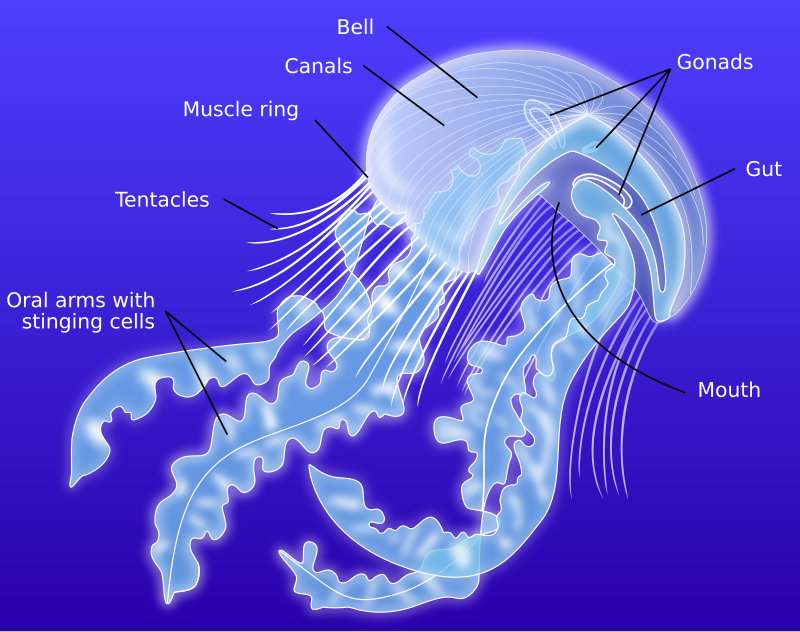
Anatomy
True jellyfish (Scyphozoa) are made of almost pure water - up to 98%. They have no bones, head, or organs, only a soft, transparent body held together by the mesoglea, a jelly-like substance that acts as a hydrostatic skeleton, giving them shape and buoyancy.
The bell, or umbrella, forms the main body, layered between the outer epidermis and inner gastrodermis. Along its edge are soft lappets that ripple as the jellyfish drifts, while delicate rhopalia hang between them - tiny sensory organs that detect light, movement, and balance.
From the centre extends the manubrium, ending in a single mouth that also serves as the anus. Four oral arms trail from it, lined with stinging nematocysts used to catch prey. Inside, the gastrovascular cavity digests food and distributes nutrients through branching canals.
They move by pulsing their bells - slow, rhythmic contractions that let them float with unhurried grace.
Nervous & Sensory System
Though brainless, jellyfish aren’t mindless. A loose nerve net woven through the skin coordinates their every motion, allowing them to sense and react to touch, light, and current.
Each rhopalium along the bell rim contains a statocyst for balance and one or more ocelli for detecting light. Most species see only light and shadow, but their relatives, the box jellyfish (Cubozoa), have 24 eyes that can perceive colour and simple shapes - granting them a near 360° awareness of the world around them.
Respiration & Circulation
Without hearts or lungs, jellyfish breathe through their skin. Oxygen diffuses directly into their tissues as the bell pulses water across the surface.
Inside, tiny cilia-lined canals move nutrients throughout the body - a simple, elegant system shaped perfectly for life adrift.
Feeding & Digestion
Tentacles and oral arms are armed with nematocysts, microscopic stinging cells that paralyse prey on contact. The captured food is drawn to the mouth and digested in the gastrovascular cavity.
Enzymes break it down, while cilia spread the nutrients through the canals. One opening serves as both mouth and anus - an ancient simplicity that endures.
Reproduction
Most species are either male or female (gonochoristic), with gonads nestled in the stomach walls. Gametes are released through the mouth into open water, where fertilisation occurs.
Some species brood their young along the oral arms, sheltering the eggs until they hatch. Others release them to drift freely among the plankton.
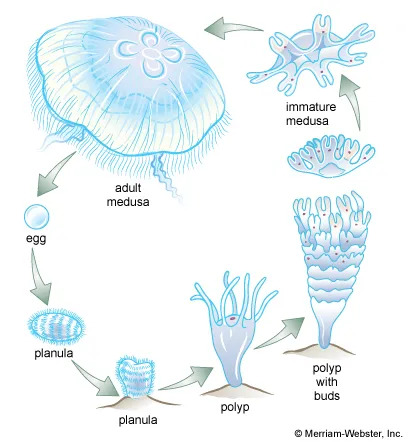
Growth & Life Cycle
A jellyfish’s life unfolds in shifting forms. After fertilisation, the egg becomes a free-swimming planula that settles onto a solid surface and grows into a tiny polyp (scyphistoma).
Through strobilation, the polyp divides into stacked discs, each breaking free as an ephyra - a miniature jellyfish. These juveniles mature into the graceful medusa, the drifting adult form we know.

How jellyfish stings work
I've never been stung by a jellyfish before, so I often wonder what it's like.
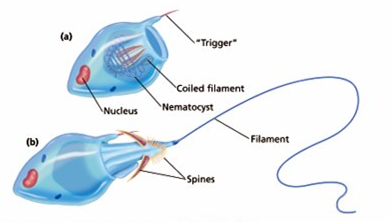
I've already mentioned cnidocytes before, but let's look at how they work. Cnidocytes are found all over the tentacles of a jellyfish. Inside these specialised cells are nematocysts, a tiny capsule that contains a venomous harpoon that's often barbed. Part (a) of the diagram shows when it's not triggered. It will remain coiled inside a fluid. The fluid consists of neurotoxins that paralyse or kill prey, accompanied by enzymes to cause tissue damage and aid in the spread of the venom. It also contains tiny amines that contribute to the inflammation experienced. The fluid is stored under immense hydrostatic pressure, sometimes exceeding 2,000 pounds per square inch. This stored energy is the "spring" for the harpoon.
Part (b) of the diagram shows the mechanism being triggered. This occurs due to a combination of stimuli. There's physical contact involved when prey brushes against a hair-like trigger on the surface of the cell called the cnidocil. But there's also chemical recognition. The nematocyst often also needs to sense specific chemicals on the target's surface (e.g., proteins or sugars) to prevent it from wasting its single shot on inanimate objects like debris.
Once triggered, the cell rapidly and dramatically changes the osmotic pressure inside the capsule, causing a sudden rush of water into the nematocyst. This massive increase in internal pressure forces the lid of the capsule to pop open, and the coiled tube is forcefully and explosively ejected. The harpoon-like thread rapidly uncoils and everts (turns inside-out) as it shoots out, accelerating at speeds claimed to exceed 5 million times the force of gravity!
Soon, the harpoon will penetrate the skin of the prey. The venom, which is a cocktail of potent neurotoxic, cardiotoxic, or hemolytic proteins, is then rapidly delivered through the hollow tube and into the victim's tissue.
This entire process is carried out in as little as 700 nanoseconds, making it one of the fastest biological processes known. If you don't think that's cool as hell then idk what is!!
For minor stings, the pain is immediate and localised. Redness, irritation and swelling are observed at the site of the sting, with the itching lasting for up to a week sometimes. Welts and an imprint of the tentacles can also be found. The initial sharp pain subsides over an hour and may turn into a feeling of numbness or tingling. These stings are, of course, uncomfortable, but you won't face any long-term consequences as long as you are treated immediately.
On the other hand, severe stings may cause intense pain, blistering, large areas of swelling, or deep skin damage. In some cases, symptoms like nausea, vomiting, difficulty breathing, muscle cramps, or chest pain are described because the venom spreads through the bloodstream. Rarely, stings from highly venomous jellies can lead to dangerous complications such as heart problems, shock, or even death without immediate medical treatment.

True jellyfish species
The following are true jellyfish. Meaning they belong to the Scyphozoa class and have the stinging cells (nematocysts)
Moon Jellyfish
.jpeg)
Common Name: Moon Jellyfish
Scientific Name: Aurelia aurita
Habitat: North, Black, Baltic and Caspian Seas, Northeast Atlantic, Greenland, northeastern USA and Canada, Northwest Pacific and South America
Water type: Temperate or tropical shallow waters near the coastline
Depth: Near the surface
Size range: 25-40 cm (10-16 in) in diameter
Lifespan: 6 months to 1 year
Sting: Harmless to humans, very mild stinging
Diet: Plankton
Distinguishing features:
- Gonads - those four clover-shaped markings you see on top of a moon jelly bell, are actually their reproductive organs!
- Short tentacles - they have hundreds of short, fine tentacles that line the edge of the bell. They're used to capture plankton and bring it into their bodies for digestion. Harmless to humans
Lion's mane jellyfish
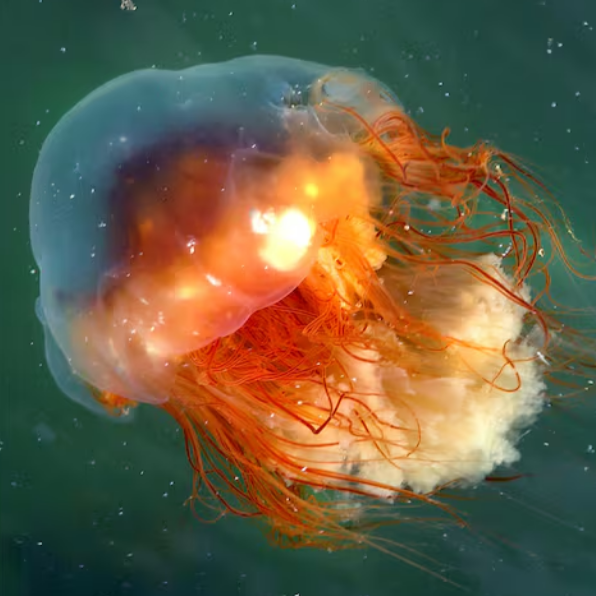
Common Name: Lion's mane jellyfish
Scientific Name: Cyanea capillata
Habitat: Arctic, northern Atlantic, and northern Pacific Oceans
Water type: Cold, boreal waters
Depth: No more than 20 m (66 ft)
Size range: 1 m (3 feet) in bell diameter. Tentacles can grow up to 30.5 m (100 feet)
Lifespan: 1 year
Sting: Venomous; causes local inflammation and temporary pain. Not fatal but medical attention may be required
Diet: Fish, zooplankton, and smaller jellyfish.
Distinguishing features:
- Largest jellyfish species in the world
- Colouration - ranges from pale yellow/orange in smaller, juvenile individuals to deep crimson or dark reddish-brown in larger, matures ones.
- Eight lobes - the bell is divided into 8 distinct lobes (radial symmetry).
- Long, hair-like tentacles - hundreds to thousands of very fine tentacles grouped in clusters, giving its shaggy appearance.
- Frilly bell edge - the bell margin has numerous folds that look ruffled, almost like a lion’s mane.
Cauliflower jellyfish
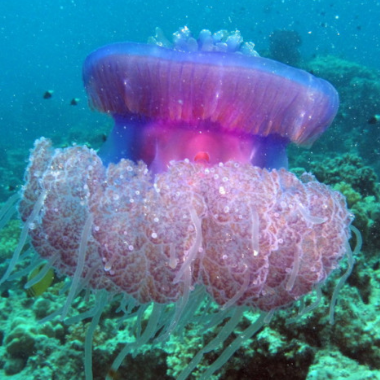
Common Name: Cauliflower jellyfish
Scientific Name: Cephea cephea
Habitat: Indo-West Pacific, eastern Atlantic and the Red Sea
Water type: Tropical and sub-tropical waters
Depth: Over 914 m (3000 feet) below the surface
Size range: Up to 60 cm (23.6 in) in diameter
Lifespan: 3 to 6 months
Sting: Harmless to humans, in fact they're considered a delicacy and are eaten by people in China and Japan. But they're very venomous to their prey
Diet: Algae, shrimp, plankton
Distinguishing features:
- Bell - the top of the bell has wart-like lumps that give it a bumpy, cauliflower-like appearance.
- Colouration - often bluish, purplish, or brownish tones.
- Short oral arms - thick, stubby arms beneath the bell used to help move food toward the mouth.
- Symbiotic hitchhiking - sometimes small fish or crustaceans live among their tentacles for protection.
White-spotted jellyfish
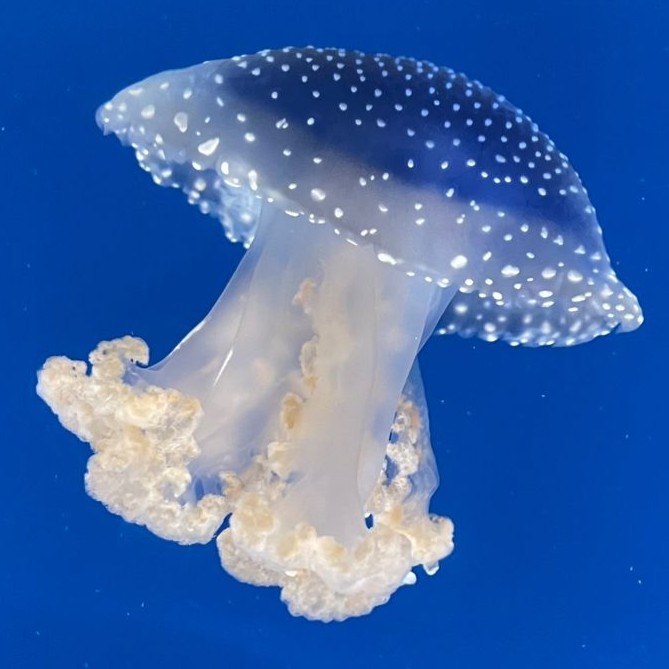
Common Name: White-spotted jellyfish
Scientific Name: Phyllorhiza punctata
Habitat: Western Pacific from Australia to Japan
Water type: Warm, temperate
Depth: Up to 20 m (65.6 feet)
Size range: Up to 50 cm (20 in) in bell diameter
Lifespan: 1 year
Sting: Mild, not a threat to humans
Diet: Zooplankton, fish eggs or larvae and small fish. They were unintentionally introduced to other regions and became an invasive species as they multiplied. They pose a threat to the fish industry as they consume fish eggs.
Distinguishing features:
- White spots - unlike most jellyfish, their bell is covered in distinct white spots, making them easy to identify.
- Frilly oral arms - they lack the long stinging tentacles common in many jellies, instead having thick, curtain-like oral arms.
Cannonball jellyfish
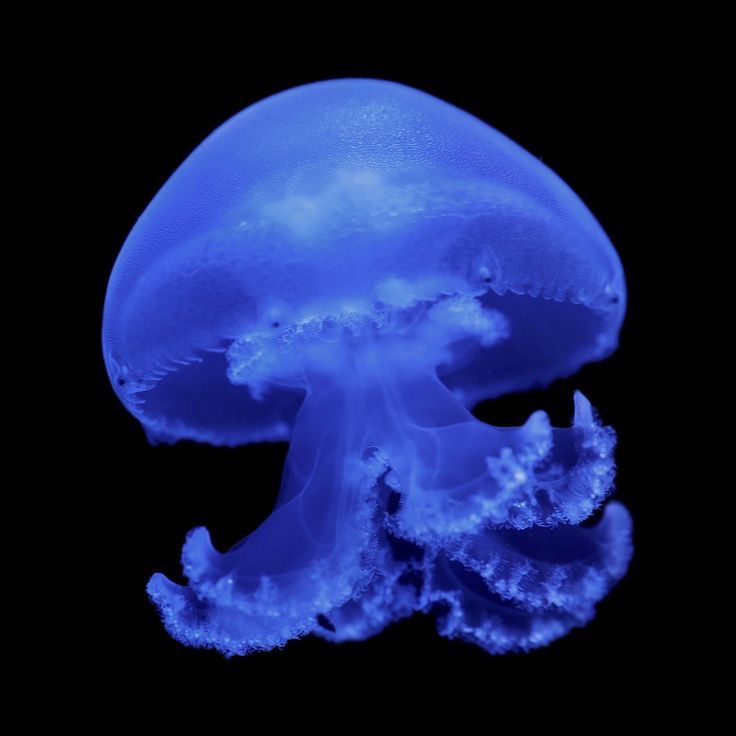
Common Name: Cannonball jellyfish
Scientific Name: Stomolophus meleagris
Habitat: Eastern Pacific, the Western Atlantic and the Western Pacific Ocean
Water type: Tropical and sub-tropical waters
Depth: up to 85 m (280 feet)
Size range: Up to 25 cm (10 in) in bell diameter, 16 cm (5 in) in height
Lifespan: 3 to 6 months
Sting: Mild, not a threat to humans
Diet: Zooplankton, fish eggs or larvae and small fish. They were unintentionally introduced to other regions and became an invasive species as they multiplied. They pose a threat to the fish industry as they consume fish eggs.
Distinguishing features:
- Shape - it has a nearly spherical, dome-shaped bell hence the name, cannonball
- Short oral arms - short, thick oral arms instead of long, trailing tentacles
Upside-down jellyfish
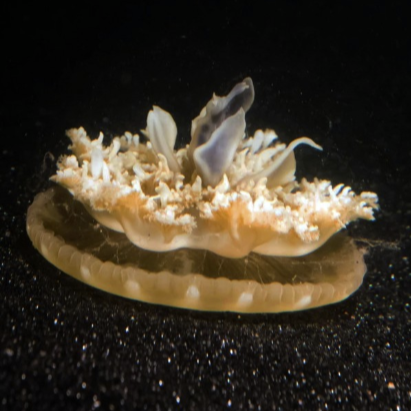
Common Name: Upside-down jellyfish
Scientific Name: Cassiopea xamachana
Habitat: Pacific, Atlantic oceans and Mediterranean sea
Water type: Shallow tropical and subtropical waters
Depth: Less than 2 m (6.5 feet)
Size range: 10–12 cm (3.9 to 4.7 in) bell width, 30.5 cm (12.01 in) in length
Lifespan: 16 months
Sting: Mild, irritating and itchy.
Diet: Zooplankton and food provided by zooxanthellae
Distinguishing features:
- Symbiotic relationship - these jellyfish have a symbiotic relationship with single-celled protists called zooxanthellae. These little guys are found in the mesogloea (the "jelly" of the jellyfish) which also gives the jellyfish a bluish-grey or bluish-green colour. So the protists provide the jellyfish nutrients via photosynthesis in exchange for shelter, like how coral!
- Upside down appearance - well I mean duh, it's in the name. Their bells are on the seafloor and their tentacles reach out. This maximises the sunlight absorption, thus increasing the rate of photosynthesis in the protists.
- Mobility - mostly sedentary, their bell is stuck to the seabed, so they don't swim around like other jellyfish.
- Sting - they can actually sting, without you touching them! First, they release a mucus into the water. This mucus contains cassiosomes, structures that are a bunch of stinging cells around a piece of jelly. They move by using their own cilia and can survive for a few days, to hunt for prey. Once they do capture prey, they sting them and the dead prey falls into the jellyfish's mouth. However, if you're not prey and just a regular human swimming by, getting into contact with cassiosomes in the water can still trigger a sting, leaving you with irritation or a painful rash.
Mauve Stinger Jellyfish
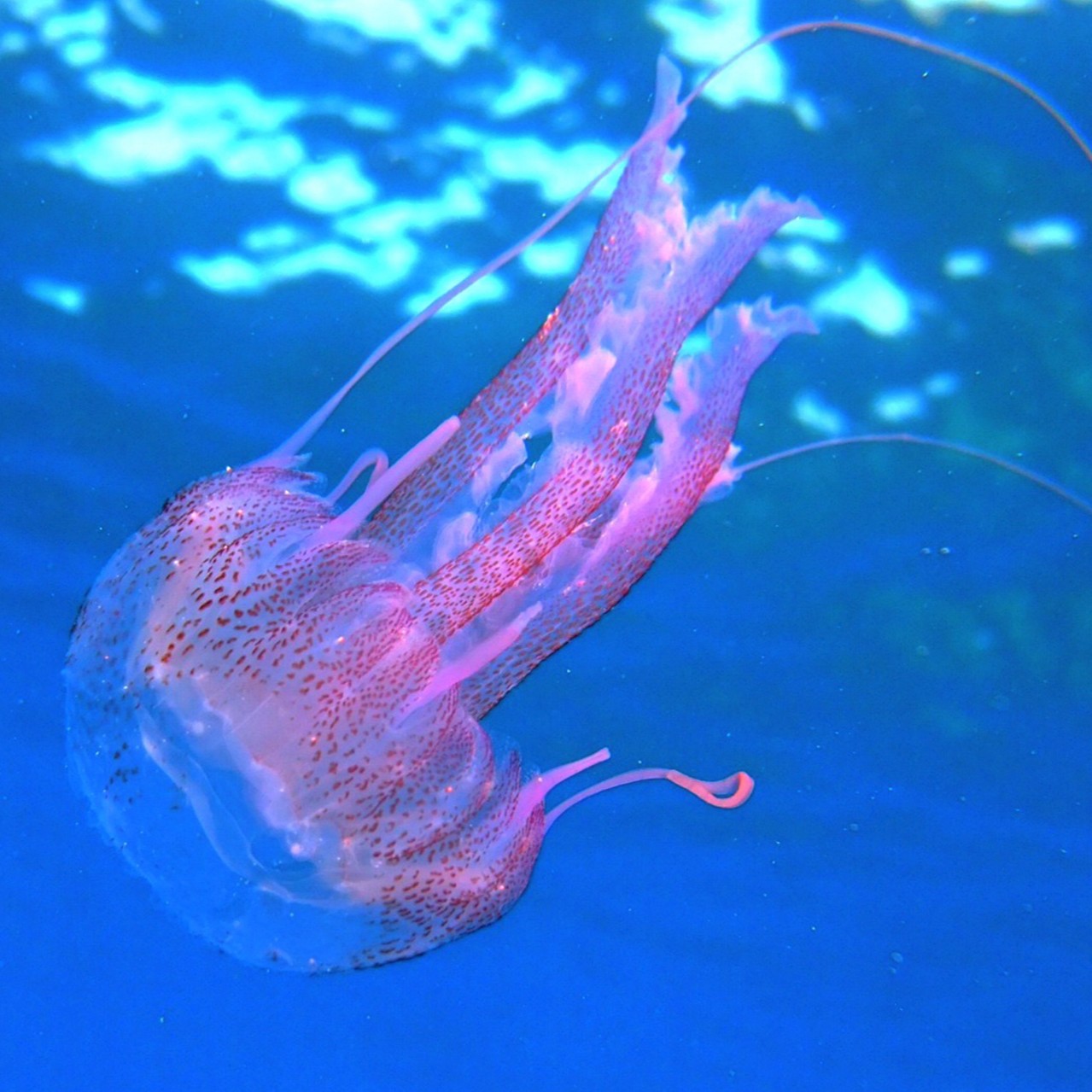
Common Name: Mauve Stinger Jellyfish
Scientific Name: Pelagia noctiluca
Habitat: Atlantic Ocean and the Mediterranean Sea
Water type: Tropical and warm temperate waters
Depth: Surface to 150 m (492 ft) (more common), recorded to 1,400 m (4593 ft)
Size range: ell diameter of 3–12 cm (1.2–4.7 in)
Lifespan: 2 to 6 months
Sting: Painful but generally not dangerous
Diet: Planktonic organisms, fish eggs, invasive comb jellies, and even members of their own species.
Distinguishing features:
- Bioluminescence - it can produce visible flashes of light when disturbed, though it is brief and gradually fades.
- Stinging cells on both bell and tentacles - most jellyfish only have cnidocytes on their tentacles only but these jellies have them on their bell too.
- No polyp stage - most jellyfish alternate between immobile polyp and free-swimming medusa stages. However, the Mauve Stinger Jellyfish has a completely pelagic (open ocean) life cycle.
- Impact - reported to have formed massive swarms (blooms) that can clog fishing nets, destroy fish farms, and shut down tourism. This is why they are one of the most studied jellyfish species.
Atolla jellyfish
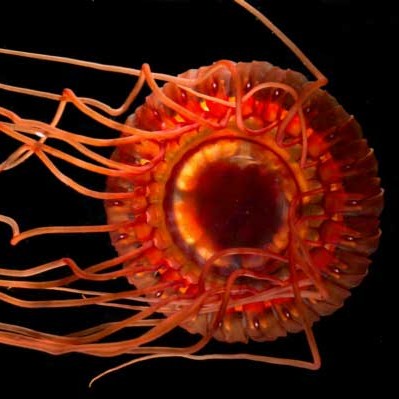
Common Name: Atolla jellyfish
Scientific Name: Atolla wyvillei
Habitat: Around the globe, deep in the ocean.
Water type: Deep waters, in the midnight zone
Depth: 1000 to 4000 m (3300 to 13100 ft)
Size range: 20–174 mm (0.79–6.85 in) in bell diameter, 3.6 m (12 ft) in length
Lifespan: Unknown
Sting: Painful, but not serious
Diet: Crustaceans and other floating nutrients
Distinguishing features:
- One extra-long tentacle - most jellyfish have tentacles of equal length, but the Atolla jellyfish has a single, much longer hypertrophied tentacle than the others, to catch prey
- Crown-like bell shape - the bell has a ridged "crown" look to it, which is why they fall under the Coronate family of true jellyfish.
- A beautiful red - the atolla jellies have a deep red colour to them, which is perfect for camouflage in the deep sea, as red light doesn't penetrate in those depths
- Burglar alarm defense - this jellyfish is bioluminescent, common in deep-sea animals. When attacked by a predator, it produces a blue flashing in propagations (circular waves) to attract a larger predator that could prey on the predator attacking the jellyfish. Interestingly, this unique adaptation inspired marine biologist Edith Widder to create the E-Jelly. A device that mimics the Atolla's alarm to lure in rare and elusive deep-sea creatures for documentation. One notable instance was when her device was used to lure and capture the video evidence of a giant squid in 2012.
Giant Phantom Jelly
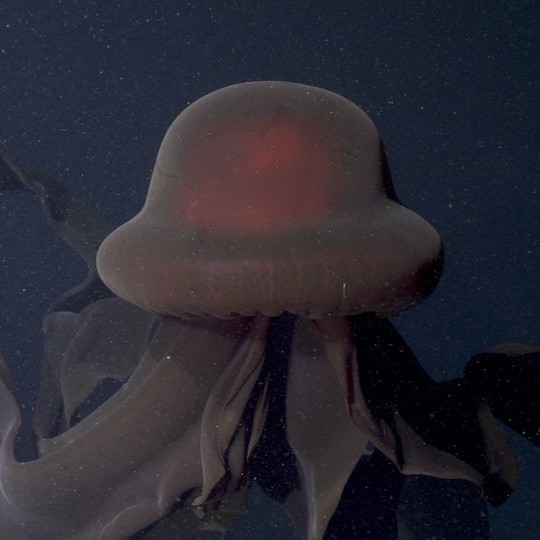
Common Name: Giant Phantom Jelly
Scientific Name: Stygiomedusa gigantea
Habitat: All around the world with the exception of the Arctic Ocean
Water type: Deep waters, in the midnight and twilight zone
Depth: 6,665 m (21,867 ft)
Size range: Bell can grow up to 1 m (3.3 ft) in diameter and 10 m (33 ft) in length
Lifespan: Unknown
Sting: None!
Diet: Plankton and small fish
Distinguishing features:
- Monotypic genus - the only species in its genus (Stygiomedusa) no other jellyfish shares its genus classification, so its genetic lineage is entirely unique.
- Size - one of the largest invertebrate predators in the deep sea.
- No stinging tentacles - they have no stinging cells at all, instead, it uses its four massive, paddle-like arms to trap and engulf prey
- Arm structure - the four arms are broad and kite-shaped, growing in a V formation from the bell’s base and tapering outward. They're flexible and can stretch to 4-5 times their resting length to envelop prey.
- Symbiotic relationship - the large umbrella-shaped bell of S. gigantea provides food and shelter for the T. pelagica, the first-ever documented symbiotic relationship from an ophidiiform fish. In return, the fish helps the jellyfish by removing parasites from its body. This relationship is important for T. pelagica, since shelter is extremely scarce in the deep ocean where both animals live. Further studies revealed that the two species will reassociate even after being separated. T. pelagica is able to locate and return to the giant phantom jellyfish using neuromasts—special sensory organs that detect low-frequency water movements emitted by the jelly’s bell.
Atlantic sea nettle
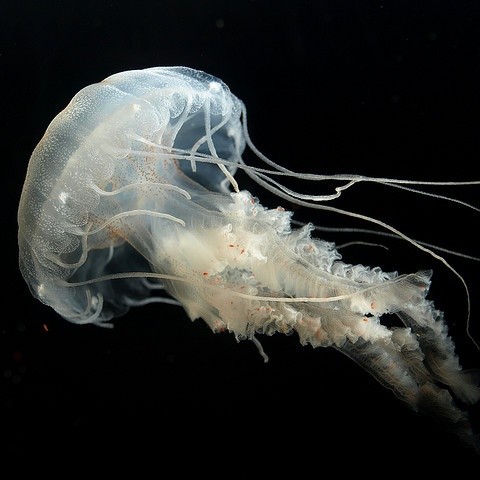
Common Name: Atlantic sea nettle
Scientific Name: Chrysaora quinquecirrha
Habitat: Atlantic coasts of the United States
Water type: Sub-tropical waters
Depth: Near the surface
Size range: 40 cm (16 in) in bell diameter and a length of 5 cm (2 in)
Lifespan: 1 year
Sting: Painful, but moderate
Diet: Zooplankton, ctenophores, other jellies, and crustaceans
Distinguishing features:
- Confusion between species - For years, the Chrysaora quinquecirrha was mistaken for other members of the Chrysaora genus. It is semi-transparent with small white spots and reddish-brown stripes on its bell.
Northern sea nettle
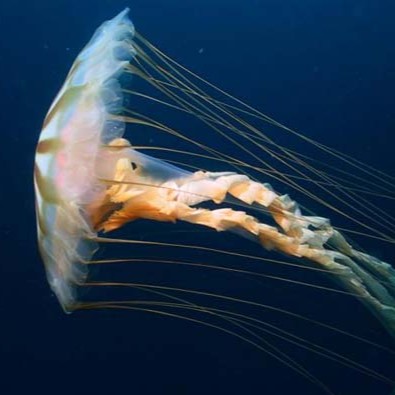
Common Name: Northern sea nettle
Scientific Name: Chrysaora melanaster
Habitat: Native to the northern Pacific Ocean and Arctic Ocean
Water type: Temperate open ocean waters
Depth: 100 m (328 ft)
Size range: Bell diameter of 60 cm (2 ft)
Lifespan: Unknown
Sting: Mild
Diet: Copepods, larvaceans, small fish, large zooplankton, and other jellies
Distinguishing features:
- Thriving - Due to climate change, the top layer of the ocean is warmer and doesn't mix with the cool layers below. So the surface water becomes warmer and food-rich, thus this species started thriving and multiplying.
Bay nettle
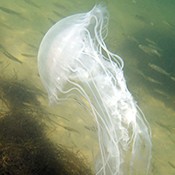
Common Name: Bay nettle
Scientific Name: Chrysaora chesapeakei
Habitat: Estuaries of the eastern coast of the U.S.A., especially Chesapeake Bay, but can also be found in the Gulf of Mexico
Water type: Coastal waters
Depth: 7 m (23 ft)
Size range: 10 cm (3.9 in) in bell diameter
Lifespan: 1 year
Sting: Moderate
Diet: Plankton, small crustaceans and ctenophores
Distinguishing features:
- Confusion between species - As mentioned before, this species was mistaken for the Chrysaora quinquecirrha. We know now that they are different, as the C. chesapeakei has a smaller bell size and fewer tentacles.
- Ecological impact - A species of ctenophore has negatively affected many of the economically important fishing industries in the Chesapeake Bay. However, since this jellyfish feeds on ctenophores, the predatory impact of the species subsides.
Pacific sea nettle
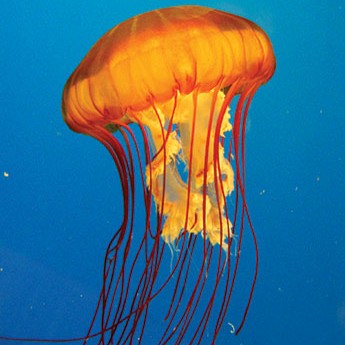
Common Name: Pacific sea nettle
Scientific Name: Chrysaora fuscescens
Habitat: Pacific Ocean
Water type: Temperate to cooler waters
Depth: No less than 100 m (328 ft)
Size range: Less than 50 cm (1.6 ft) wide in bell diameter and 15 feet (4.6 m) in tentacle length.
Lifespan: 6 months
Sting: Moderate
Diet: Zooplankton, crustaceans, salps, pelagic snails, small fish including their eggs and larvae, and other jellyfish
Distinguishing features:
- Colour - They have a golden-brown bell with a reddish tint
- Captivity - Popular cnidarian species in aquariums due to their bright colours, long tentacles but also because of their low maintenance.
- Hitchhikers - Often carry small hitchhikers like fish or crabs inside its bell.
Japanese sea nettle
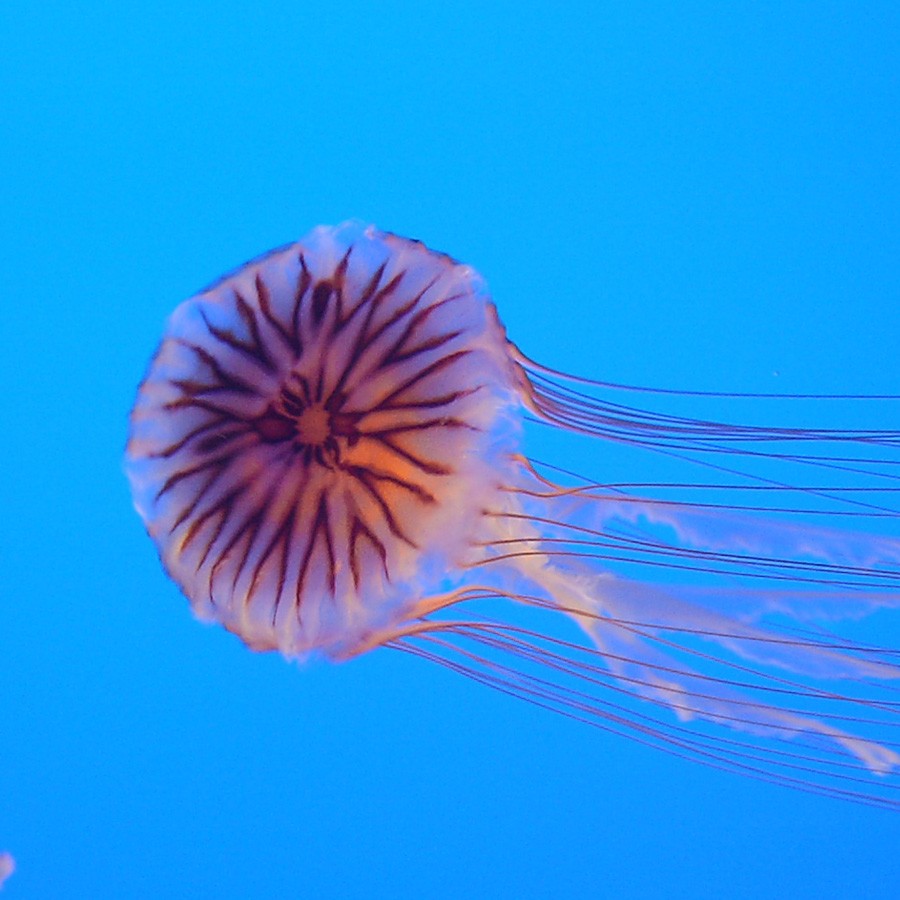
Common Name: Japanese sea nettle
Scientific Name: Chrysaora pacifica
Habitat: Pacific Ocean
Water type: Temperate
Depth: No less than 100 m (328 ft)
Size range: Bell with a diameter of 15–21 cm (5.9–8.3 in)
Lifespan: 6 months
Sting: Strong
Diet: Zooplankton, including small crustaceans and other jellyfish
Distinguishing features:
- Accidental discovery - In 2009, a Japanese scientist was looking fro a different jellyfish species when he came across the polyps of this species, attached to dead crabs and shells.
- Confusion between species - Often confused with Chrysaora melanaster which is much larger. This jelly on the other hand, has distinguishing red stripes on its bell and is smaller in size.
Black sea nettle
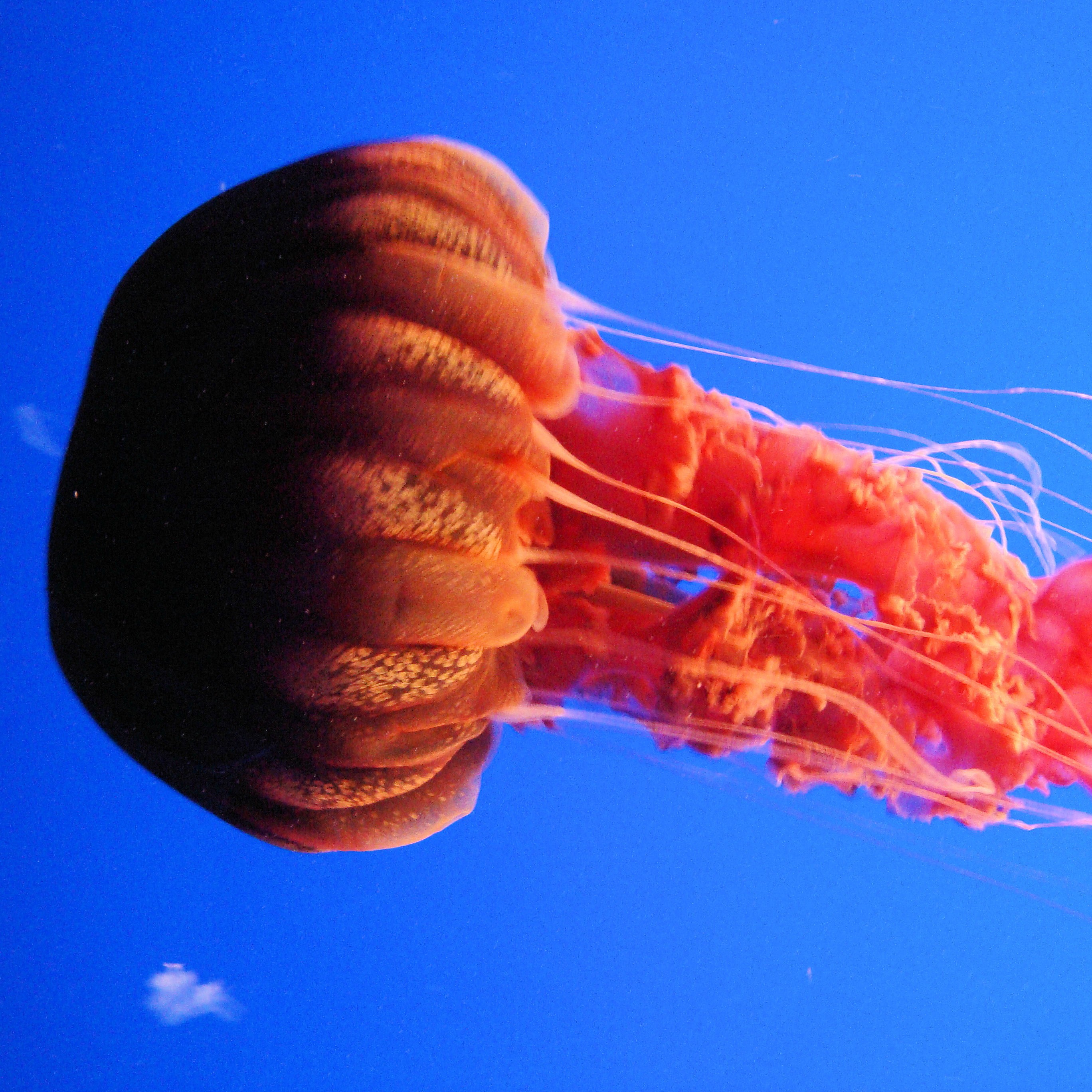
Common Name: Pacific sea nettle
Scientific Name: Chrysaora achlyos
Habitat: Pacific Ocean
Water type: Temperate
Depth: No less than 100 m (328 ft)
Size range: Bell diameter potentially up to 1 m (3 ft) and arms extending to 5 m (16 ft)
Lifespan: 6 months
Sting: Moderate
Diet: Zooplankton and other jellyfish
Distinguishing features:
- Size - It was actually the largest invertebrate species formally described in the 20th century.
- Rarity - Often disappears for years at a time, then suddenly appears in massive swarms. Sightings often coincide with red tide events, suggesting a link to blooms of their zooplankton prey.
UNDER CONSTRUCTION!!1 more to come :P
Common Name:
Scientific Name:
Habitat:
Water type:
Depth:
Size range:
Lifespan:
Sting:
Diet:
Distinguishing features:
© caramelpuddinz 2025 - all rights reserved

